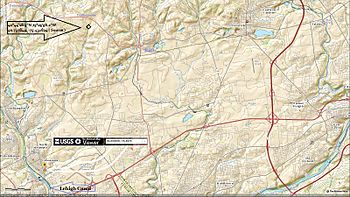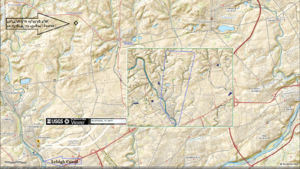Catasauqua Creek facts for kids
Quick facts for kids Catasauqua Creek16 Variant Names |
|
|---|---|

USGS source and mouth of Catasauqua Creek watercourse in Catasaugua, PA
|
|
| Native name | Gattawissi |
| Physical characteristics | |
| Main source | Northampton, PA ~2,052 feet (625 m) south of Pheasant Drive, county road 248, (in the dell between Hilltop Rd and Sickle Rd., ~3,530 feet (1,080 m) north of their junction. 610 feet (186 m) 40°44′16″N 75°26′01″W / 40.7377778°N 75.4336111°W |
| River mouth | In Catasauqua opposite West Catasauqua & Allentown just south of the Race/W.Race Street Bridge on the Lehigh River below the Lehigh Gap and north of Bethlehem, PA. 272 ft (83 m) 40°38′49″N 75°28′08″W / 40.647011°N 75.468957°W |
| Length | 14.9 mi (24.0 km) |
Catasauqua Creek is a stream in Pennsylvania. It flows from springs in the Blue Mountain area. This mountain range is part of the Ridge-and-Valley Appalachians. The creek runs through Lehigh and Northampton counties. It flows for about 14.9 miles (24 km).
The creek's mouth is in Catasauqua, Pennsylvania, across from West Catasauqua, Pennsylvania. It flows into the Lehigh River. In the 1800s, a bridge was built over the Lehigh River near the creek's mouth. This bridge helped carry heavy loads of iron ore. The ore was used for new iron factories in the area. These factories were important for the growing iron industry in the Lehigh Valley.
The creek starts in the Dannersville area of Bath. It quickly forms a deep valley. As it flows, it collects water from two other smaller streams. It then leaves the steep hills and flows more gently for its last few miles.
Contents
Catasauqua Creek's Role in History
Catasauqua Creek played a big part in American history. It was chosen in 1839 as a source of water power. This power was needed for a new company called the Lehigh Crane Iron Company. This company was started by Erskine Hazard and Josiah White. They were also founders of the Lehigh Coal & Navigation Company.
Early Iron Production
The Lehigh Crane Iron Company brought in an expert from Wales, David Thomas. His job was to build and run special furnaces. These furnaces were designed to make pig iron. Pig iron is a basic type of iron. What made these furnaces special was that they used anthracite coal as fuel. Anthracite is a very hard, clean-burning type of coal.
Six of the first eight successful furnaces in North America that used anthracite coal were built along Catasauqua Creek. This was a major breakthrough! Using anthracite made iron much cheaper and easier to get. This new way of making iron helped kickstart the American Industrial Revolution.
A Historic Moment
The first successful batch of iron made with anthracite coal happened on July 4, 1840. This event was very important. Historians Ann Bartholomew and Lance E. Metz wrote about it:
From that moment on, anthracite and the canals pivotal importance in the industrial development of the United States.
Using anthracite as fuel in its production, iron for the first time became plentiful and inexpensive. For a period of thirty years, three decades that shaped the future of the valley, anthracite fueled furnaces throughout the Lehigh Valley produced greater quantities of iron than any other part of the nation.—Ann Bartholomew & Lance E. Metz, page 5
For about 30 years, the Lehigh Valley made more iron than any other part of the country. This was all thanks to anthracite coal and the furnaces along creeks like Catasauqua Creek.
Where the Creek Flows
The Catasauqua Creek flows into the Lehigh River from its east side. It is sometimes called the "catty creek."
Creek's Journey
The creek's source is near Miller State Pond in East Allen Township, Northampton County, Pennsylvania. It then flows through Allen Township, Northampton County, Pennsylvania. After that, it passes through North Catasauqua and finally into Catasauqua, Pennsylvania. In Catasauqua, it joins the Lehigh Canal and River. Along its path, the creek flows past Catasauqua High School. It also goes through Willowbrook Golf Course and Catasauqua Park.
Other Names for the Creek
Over time, the people living near Catasauqua Creek changed. First, there were Irish settlers, then mostly German families. This might be why the creek has so many different names.
The USGS (United States Geological Survey) keeps track of geographic names. Here are some other names that have been used for Catasauqua Creek:
- Caladaqua Creek
- Caladoque Creek
- Calandaqua Creek
- Calesoque Creek
- Calisuk Creek
- Catasocque Creek
- Coladaque Creek
- Colesauque Creek
- Colesoque Creek
- Colesquque Creek
- Collasauque Creek
- Gatasaque Creek
- Gattoshacki Creek
- Gottoschacki Creek
- Gottshacki Creek
- Mill Creek


